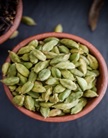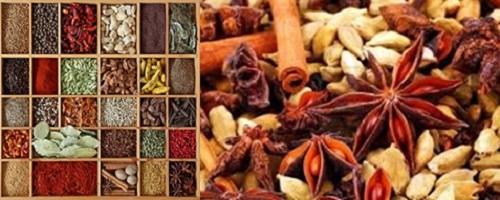The Great Indian Spice Trail
India is known as ‘the home of spices’. From the ancient times India has been a hub of spice cultivation, processing and export. Spices are well-known as appetisers and are considered essential in the culinary art all over the world
Spices are used in different forms: whole, chopped, ground, roasted, sautéed, fried, and as topping. They blend food to extract the nutrients and bind them in a palatable form Lighter spices are added last, and spices with strong flavour should be added first. “Curry” is not a spice, an exotic blend of a few spices in correct proportions to get delicious and different gravies.
Apart from adding colour, flavour and taste, consumption of spices provide infinite health and medical benefits.
- Turmeric
This bright orange spice is great for adding color to your dish, since thousands of years, Ayurvedic medicine has used turmeric for a variety of health reasons- turmeric aids in helping to treat arthritis, heartburn, stomach pain, diarrhea, intestinal gas, stomach bloating, and loss of appetite. Turmeric is also used as a topical treatment for issues like skin inflammation, infected wounds, and ringworm.
- Black Pepper
Is one of the most traded spices in the world and are commonly found in many European dishes, often paired with salt. needs to be toasted before blending. For the best flavor, however, fresh black pepper can also be ground directly into dishes. Black pepper aids in digestion, congestion, an upset stomach and can also help to stop the bleeding on a cut when applied topically.
- Cardamom
Cardamom is the “queen of spices”; 
these green pods are used also in Chai—Indian tea. It can be used to counteract a number of digestive problems including, bloating, gas, heartburn and loss of appetite—treat bad breath and also as an after-meal breath freshener.
- Cloves
 In cosmetic uses, cloves is found in toothpastes, soaps, and perfumes, Clove oil can also help with pain when applied topically, is very effective especially for toothache.
In cosmetic uses, cloves is found in toothpastes, soaps, and perfumes, Clove oil can also help with pain when applied topically, is very effective especially for toothache.
- Cinnamon
Helps regulate treatment for people with type 2 diabetes. The theory is that cinnamon increases insulin action.
- Chillies (mirch):Your eyes may start watering just with the name of it, but you would be surprised to know that. They have been used externally to relieve pain and internally to cure anything from yellow fever to the common cold. The active ingredient in hot red peppers is a compound called capsaicin, which gives it that unique sting. Capsaicin triggers the release of endorphins in the brain, which has a pain relieving effect similar to that of morphine. Their high vitamin C content can also substantially increase the absorption of non-heme iron from other ingredients in a meal, such as beans and grains.
Saffron
The most expensive spice in the world, saffron is actually more valuable by weight than gold, due to the fact that it is one of the most labor-intensive spices to produce. Saffron is an intense spice, and is used in small quantities, usually dissolved in warm water or milk before being added to dishes.
 Though these spices provide innumerable benefits they should be used sparingly. The excessive use of spices in food can cause harm to the health. Try to make specific use of these spices. This will help you to make optimal use of the resources provided by nature. Strike the right balance and add some spice to your life.
Though these spices provide innumerable benefits they should be used sparingly. The excessive use of spices in food can cause harm to the health. Try to make specific use of these spices. This will help you to make optimal use of the resources provided by nature. Strike the right balance and add some spice to your life.
These are a just a few of a whole big variety of spices used in Indian cooking !
This article has been provided by Delhi Durbar, a one of its kind, Authentic Indian Cusine Restaurant in Vientiane, Laos !!


